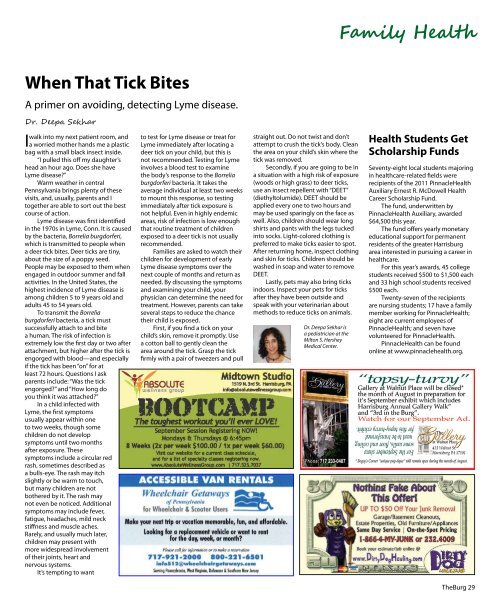August 2011 Greater Harrisburg's Community Newspaper - theBurg
August 2011 Greater Harrisburg's Community Newspaper - theBurg
August 2011 Greater Harrisburg's Community Newspaper - theBurg
You also want an ePaper? Increase the reach of your titles
YUMPU automatically turns print PDFs into web optimized ePapers that Google loves.
Family Health<br />
When That Tick Bites<br />
A primer on avoiding, detecting Lyme disease.<br />
Dr. Deepa Sekhar<br />
walk into my next patient room, and<br />
I a worried mother hands me a plastic<br />
bag with a small black insect inside.<br />
“I pulled this off my daughter’s<br />
head an hour ago. Does she have<br />
Lyme disease”<br />
Warm weather in central<br />
Pennsylvania brings plenty of these<br />
visits, and, usually, parents and I<br />
together are able to sort out the best<br />
course of action.<br />
Lyme disease was first identified<br />
in the 1970s in Lyme, Conn. It is caused<br />
by the bacteria, Borrelia burgdorferi,<br />
which is transmitted to people when<br />
a deer tick bites. Deer ticks are tiny,<br />
about the size of a poppy seed.<br />
People may be exposed to them when<br />
engaged in outdoor summer and fall<br />
activities. In the United States, the<br />
highest incidence of Lyme disease is<br />
among children 5 to 9 years old and<br />
adults 45 to 54 years old.<br />
To transmit the Borrelia<br />
burgdorferi bacteria, a tick must<br />
successfully attach to and bite<br />
a human. The risk of infection is<br />
extremely low the first day or two after<br />
attachment, but higher after the tick is<br />
engorged with blood—and especially<br />
if the tick has been “on” for at<br />
least 72 hours. Questions I ask<br />
parents include: “Was the tick<br />
engorged” and “How long do<br />
you think it was attached”<br />
In a child infected with<br />
Lyme, the first symptoms<br />
usually appear within one<br />
to two weeks, though some<br />
children do not develop<br />
symptoms until two months<br />
after exposure. These<br />
symptoms include a circular red<br />
rash, sometimes described as<br />
a bulls-eye. The rash may itch<br />
slightly or be warm to touch,<br />
but many children are not<br />
bothered by it. The rash may<br />
not even be noticed. Additional<br />
symptoms may include fever,<br />
fatigue, headaches, mild neck<br />
stiffness and muscle aches.<br />
Rarely, and usually much later,<br />
children may present with<br />
more widespread involvement<br />
of their joints, heart and<br />
nervous systems.<br />
It’s tempting to want<br />
to test for Lyme disease or treat for<br />
Lyme immediately after locating a<br />
deer tick on your child, but this is<br />
not recommended. Testing for Lyme<br />
involves a blood test to examine<br />
the body’s response to the Borrelia<br />
burgdorferi bacteria. It takes the<br />
average individual at least two weeks<br />
to mount this response, so testing<br />
immediately after tick exposure is<br />
not helpful. Even in highly endemic<br />
areas, risk of infection is low enough<br />
that routine treatment of children<br />
exposed to a deer tick is not usually<br />
recommended.<br />
Families are asked to watch their<br />
children for development of early<br />
Lyme disease symptoms over the<br />
next couple of months and return as<br />
needed. By discussing the symptoms<br />
and examining your child, your<br />
physician can determine the need for<br />
treatment. However, parents can take<br />
several steps to reduce the chance<br />
their child is exposed.<br />
First, if you find a tick on your<br />
child’s skin, remove it promptly. Use<br />
a cotton ball to gently clean the<br />
area around the tick. Grasp the tick<br />
firmly with a pair of tweezers and pull<br />
straight out. Do not twist and don’t<br />
attempt to crush the tick’s body. Clean<br />
the area on your child’s skin where the<br />
tick was removed.<br />
Secondly, if you are going to be in<br />
a situation with a high risk of exposure<br />
(woods or high grass) to deer ticks,<br />
use an insect repellent with “DEET”<br />
(diethyltolumide). DEET should be<br />
applied every one to two hours and<br />
may be used sparingly on the face as<br />
well. Also, children should wear long<br />
shirts and pants with the legs tucked<br />
into socks. Light-colored clothing is<br />
preferred to make ticks easier to spot.<br />
After returning home, inspect clothing<br />
and skin for ticks. Children should be<br />
washed in soap and water to remove<br />
DEET.<br />
Lastly, pets may also bring ticks<br />
indoors. Inspect your pets for ticks<br />
after they have been outside and<br />
speak with your veterinarian about<br />
methods to reduce ticks on animals.<br />
Dr. Deepa Sekhar is<br />
a pediatrician at the<br />
Milton S. Hershey<br />
Medical Center.<br />
Health Students Get<br />
Scholarship Funds<br />
Seventy-eight local students majoring<br />
in healthcare-related fields were<br />
recipients of the <strong>2011</strong> PinnacleHealth<br />
Auxiliary Ernest R. McDowell Health<br />
Career Scholarship Fund.<br />
The fund, underwritten by<br />
PinnacleHealth Auxiliary, awarded<br />
$64,500 this year.<br />
The fund offers yearly monetary<br />
educational support for permanent<br />
residents of the greater Harrisburg<br />
area interested in pursuing a career in<br />
healthcare.<br />
For this year’s awards, 45 college<br />
students received $500 to $1,500 each<br />
and 33 high school students received<br />
$500 each.<br />
Twenty-seven of the recipients<br />
are nursing students; 17 have a family<br />
member working for PinnacleHealth;<br />
eight are current employees of<br />
PinnacleHealth; and seven have<br />
volunteered for PinnacleHealth.<br />
PinnacleHealth can be found<br />
online at www.pinnaclehealth.org.<br />
TheBurg 29









